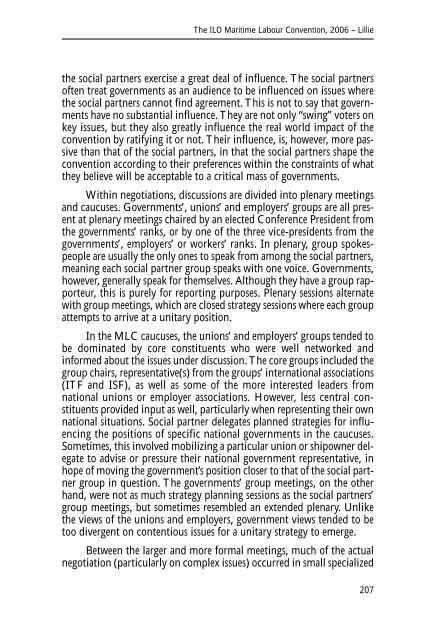CROSS-BORDER SOCIAL DIALOGUE AND AGREEMENTS: An ...
CROSS-BORDER SOCIAL DIALOGUE AND AGREEMENTS: An ...
CROSS-BORDER SOCIAL DIALOGUE AND AGREEMENTS: An ...
Create successful ePaper yourself
Turn your PDF publications into a flip-book with our unique Google optimized e-Paper software.
The ILO Maritime Labour Convention, 2006 – Lillie<br />
the social partners exercise a great deal of influence. The social partners<br />
often treat governments as an audience to be influenced on issues where<br />
the social partners cannot find agreement. This is not to say that governments<br />
have no substantial influence. They are not only “swing” voters on<br />
key issues, but they also greatly influence the real world impact of the<br />
convention by ratifying it or not. Their influence, is, however, more passive<br />
than that of the social partners, in that the social partners shape the<br />
convention according to their preferences within the constraints of what<br />
they believe will be acceptable to a critical mass of governments.<br />
Within negotiations, discussions are divided into plenary meetings<br />
and caucuses. Governments’, unions’ and employers’ groups are all present<br />
at plenary meetings chaired by an elected Conference President from<br />
the governments’ ranks, or by one of the three vice-presidents from the<br />
governments’, employers’ or workers’ ranks. In plenary, group spokespeople<br />
are usually the only ones to speak from among the social partners,<br />
meaning each social partner group speaks with one voice. Governments,<br />
however, generally speak for themselves. Although they have a group rapporteur,<br />
this is purely for reporting purposes. Plenary sessions alternate<br />
with group meetings, which are closed strategy sessions where each group<br />
attempts to arrive at a unitary position.<br />
In the MLC caucuses, the unions’ and employers’ groups tended to<br />
be dominated by core constituents who were well networked and<br />
informed about the issues under discussion. The core groups included the<br />
group chairs, representative(s) from the groups’ international associations<br />
(ITF and ISF), as well as some of the more interested leaders from<br />
national unions or employer associations. However, less central constituents<br />
provided input as well, particularly when representing their own<br />
national situations. Social partner delegates planned strategies for influencing<br />
the positions of specific national governments in the caucuses.<br />
Sometimes, this involved mobilizing a particular union or shipowner delegate<br />
to advise or pressure their national government representative, in<br />
hope of moving the government’s position closer to that of the social partner<br />
group in question. The governments’ group meetings, on the other<br />
hand, were not as much strategy planning sessions as the social partners’<br />
group meetings, but sometimes resembled an extended plenary. Unlike<br />
the views of the unions and employers, government views tended to be<br />
too divergent on contentious issues for a unitary strategy to emerge.<br />
Between the larger and more formal meetings, much of the actual<br />
negotiation (particularly on complex issues) occurred in small specialized<br />
207
















